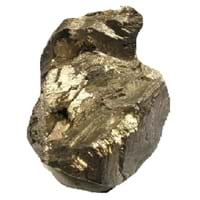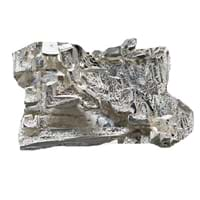Bismuth Silver Comparison
Periodic Table
Symbol
Bi
Ag
Group Number
15
3
11
7
Period Number
6
5
Block
p block
d block
Element Family
Post-Transition
Transition Metal
CAS Number
7440699
22
7440224
99+
Space Group Name
C12/m1
Fm_ 3m
Space Group Number
12.00
12
225.00
2
Facts
Interesting Facts
- Bismuth metal is soluble and reacts with concentrated nitric acid.
- It oxides are used as a yellow pigment in paint. Bismuth chloride oxide BiClO gives a pearly texture to cosmetics.
- It is the most reflective element.
- Silver is the second most ductile metal after Gold.
- It is also used in Dentistry as a dental alloys for clips and crowning.
Sources
Found in Minerals, Mining, Ores of Minerals
Earth's crust, Found in Minerals, Ores of metals
History
Who Discovered
Claude François Geoffroy
Unknown
Discovery
In 1753
Before 5000 BC
Abundance
Abundance In Universe
7 * 10-8 %
25
6 * 10-8 %
26
Abundance In Sun
~0.000006 %
14
~0.0000001 %
26
Abundance In Meteorites
0.00 %
99+
0.00 %
38
Abundance In Earth's Crust
0.00 %
99+
0.00 %
99+
Abundance In Oceans
0.00 %
24
0.00 %
19
Uses
Uses & Benefits
- Tin and bismuth alloys have a very low melting point and hence it is used in fire detector and the fire extinguishers. It also used in electric solders and fuses.
- Silver is mainly used for Jewelry and show piece.
- It is used for manufacturing high quality mirrors due to its reflectivity property.
Industrial Uses
Automobile Industry, Chemical Industry, Electrical Industry, Electronic Industry
Chemical Industry, Clothing Industry, Electrical Industry
Medical Uses
Pharmaceutical Industry
Dentistry, Pharmaceutical Industry
Other Uses
Alloys
Alloys, Bullion, Coinage, Jewellery, Sculptures, Statues
Biological Properties
Toxicity
Low Toxic
Non Toxic
Present in Human Body
Yes
Yes
In Blood
0.02 Blood/mg dm-3
20
0.00 Blood/mg dm-3
29
In Bone
0.20 p.p.m.
22
0.44 p.p.m.
20
Physical Properties
Melting Point
271.30 °C
99+
961.93 °C
99+
Boiling Point
1,560.00 °C
99+
2,212.00 °C
99+
Appearance
Physical State
Solid
Solid
Color
Silver
Silvery White
Luster
Metallic
Metallic
Hardness
Mohs Hardness
2.25
15
2.50
14
Brinell Hardness
70.00 MPa
99+
251.00 MPa
37
Vickers Hardness
Not Available
229.00 MPa
30
Speed of Sound
1,790.00 m/s
99+
2,680.00 m/s
34
Optical Properties
Reflectivity
Not Available
97.00 %
1
Allotropes
No
No
α Allotropes
Not Available
Not Available
β Allotropes
Not Available
Not Available
γ Allotropes
Not Available
Not Available
Chemical Properties
Chemical Formula
Bi
Ag
Isotopes
Known Isotopes
33
6
36
3
Electronegativity
Pauling Electronegativity
2.02
6
1.93
9
Sanderson Electronegativity
2.34
3
1.83
11
Allred Rochow Electronegativity
1.67
6
1.42
18
Mulliken-Jaffe Electronegativity
2.15
4
1.47
15
Allen Electronegativity
2.01
4
1.87
7
Electropositivity
Pauling Electropositivity
1.98
99+
2.07
99+
Ionization Energies
1st Energy Level
703.00 kJ/mol
35
731.00 kJ/mol
27
2nd Energy Level
1,610.00 kJ/mol
33
2,070.00 kJ/mol
11
3rd Energy Level
2,466.00 kJ/mol
99+
3,361.00 kJ/mol
19
4th Energy Level
4,370.00 kJ/mol
28
Not Available
5th Energy Level
5,400.00 kJ/mol
30
Not Available
6th Energy Level
8,520.00 kJ/mol
19
Not Available
Electrochemical Equivalent
2.60 g/amp-hr
19
4.02 g/amp-hr
7
Electron Work Function
4.22 eV
22
4.26 eV
20
Other Chemical Properties
Ionization, Radioactive Isotopes, Solubility
Chemical Stability, Ionization, Solubility
Atomic Properties
Atomic Number
83
33
47
99+
Electron Configuration
[Xe] 4f14 5d10 6s2 6p3
[Kr] 4d10 5s1
Crystal Structure
Rhombohedral (RHO)
Face Centered Cubic (FCC)
Crystal Lattice
RHO-Crystal-Structure-of-Bismuth.jpg#100
FCC-Crystal-Structure-of-Silver.jpg#100
Atom
Number of Protons
83
33
47
99+
Number of Neutrons
126
18
61
99+
Number of Electrons
83
33
47
99+
Radius of an Atom
Atomic Radius
156.00 pm
29
144.00 pm
36
Covalent Radius
148.00 pm
36
145.00 pm
39
Van der Waals Radius
207.00 pm
26
172.00 pm
38
Atomic Weight
208.98 amu
29
107.87 amu
99+
Atomic Volume
21.30 cm3/mol
14
10.30 cm3/mol
99+
Adjacent Atomic Numbers
Valence Electron Potential
41.90 (-eV)
99+
11.40 (-eV)
99+
Lattice Constant
667.40 pm
2
408.53 pm
20
Lattice Angles
NA
π/2, π/2, π/2
Lattice C/A Ratio
Not Available
Not Available
Mechanical Properties
Density
Density At Room Temperature
9.78 g/cm3
39
10.49 g/cm3
35
Density When Liquid (at m.p.)
10.05 g/cm3
18
9.32 g/cm3
21
Tensile Strength
Not Available
Not Available
Viscosity
Not Available
Not Available
Vapor Pressure
Vapor Pressure at 1000 K
Not Available
0.00 (Pa)
14
Elasticity properties
Shear Modulus
12.00 GPa
99+
30.00 GPa
23
Bulk Modulus
31.00 GPa
38
100.00 GPa
16
Young's Modulus
32.00 GPa
99+
83.00 GPa
23
Poisson Ratio
0.33
11
0.37
7
Other Mechanical Properties
NA
Ductile, Malleable
Magnetic Properties
Magnetic Characteristics
Specific Gravity
9.79
30
10.50
26
Magnetic Ordering
Diamagnetic
Diamagnetic
Permeability
0.00 H/m
6
Not Available
Susceptibility
0.00
6
0.00
5
Electrical Properties
Electrical Property
Semiconductor
Conductor
Resistivity
1.29 nΩ·m
99+
15.87 nΩ·m
99+
Electrical Conductivity
0.01 106/cm Ω
99+
0.63 106/cm Ω
1
Electron Affinity
91.20 kJ/mol
11
125.60 kJ/mol
5
Thermal Properties
Specific Heat
0.12 J/(kg K)
40
0.24 J/(kg K)
25
Molar Heat Capacity
25.52 J/mol·K
37
25.35 J/mol·K
99+
Thermal Conductivity
7.97 W/m·K
99+
429.00 W/m·K
1
Critical Temperature
Not Available
Not Available
Thermal Expansion
13.40 µm/(m·K)
28
18.90 µm/(m·K)
23
Enthalpy
Enthalpy of Vaporization
151.00 kJ/mol
99+
255.10 kJ/mol
37
Enthalpy of Fusion
10.90 kJ/mol
33
11.30 kJ/mol
31
Enthalpy of Atomization
207.10 kJ/mol
99+
284.50 kJ/mol
37
Standard Molar Entropy
56.70 J/mol.K
24
42.60 J/mol.K
35
|
||
|
||
|












